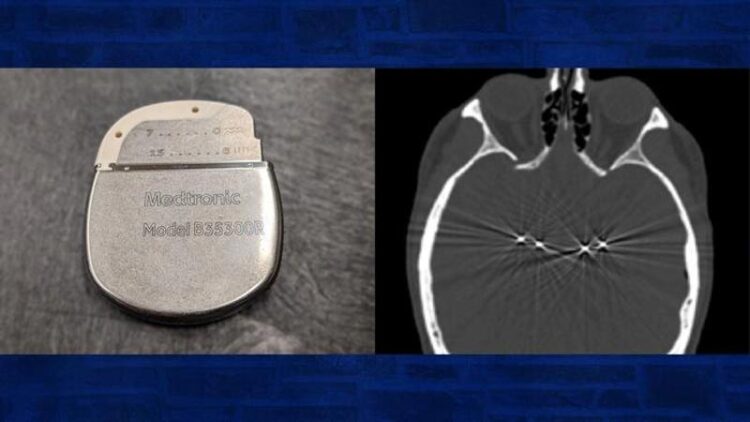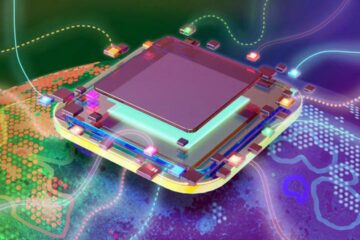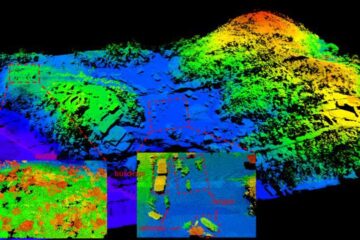Engineering a more elegant deep brain stimulation therapy for Parkinson’s

The new device (left) acts like a pacemaker that can adjust the parameters of stimulation automatically. The CT scan (right) shows the placement of four electrodes to deliver the stimulation.
Credit: Duke University
Adaptive form of deep brain stimulation with twice the number of electrodes improved the symptoms of Parkinson’s disease in six patients.
A team of physicians, neuroscientists and engineers at Duke University has demonstrated two new strategies that use deep brain stimulation to improve the symptoms of Parkinson’s disease.
By simultaneously targeting two key brain structures and using a novel self-adjusting device, the team showed that they can efficiently target and improve disruptive symptoms caused by the movement disorder.
The research appears online in the journal Brain.
For the past 20 years physicians have prescribed deep brain stimulation, or DBS, to treat the symptoms of advanced Parkinson’s disease when medication alone will no longer work. The technique uses a device similar to a pacemaker to deliver electric impulses to key areas within the brain. This targeted stimulation can reduce tremors and stiffness and limit the involuntary, writhing movements that develop after years of medication.
While DBS has proven to be an effective therapy to address these symptoms, it isn’t perfect, and physicians and researchers continue to explore ways to make improvements.
“Physicians place the electrodes for DBS in either the subthalamic nucleus or the globus pallidus, which are two structures in the brain closely associated with movement,” said senior author Dennis Turner, professor of neurosurgery, neurobiology, and biomedical engineering at the Duke University School of Medicine, who conceived and organized the research and assembled the interdisciplinary team.
“There are benefits to both locations on their own depending on the patient’s symptoms,” Turner said, “but we believed placing the electrodes at both locations could be complementary and help reduce medication doses and side effects, as well as implement a completely new approach to adaptive DBS.”
Beyond increasing the area of stimulation, the team wanted to explore whether a technique called adaptive DBS could make their system more efficient. In traditional DBS, a physician sets key electrical parameters, like the amplitude, pulse frequency and pulse duration, to best treat symptoms while minimizing side effects. Those parameters may stay the same for days, weeks, months and even years, depending on the patient’s response.
But according to Warren Grill, the Edmund T. Pratt, Jr. School Distinguished Professor of Biomedical Engineering at Duke, these unchanging parameters are far from optimal.
“The amount of stimulation a person living with Parkinson’s needs changes, depending on their medications or activity levels. A patient will need more stimulation if they are walking their daughter down the aisle at her wedding than if they are just watching TV,” Grill said. An adaptive system is “like a smart thermostat in your office that makes adjustments based on the temperature outside.”
To implement their bespoke approach, the team worked with experimental technology provided by the medical device company Medtronic to create their own adaptive DBS techniques. By programming the device to sense and record key biomarkers and brain activity in the patient, the researchers developed a system that can adjust the parameters of stimulation automatically to provide optimal symptom relief throughout the day.
The team tested their strategies in a clinical trial at Duke University Medical Center with six patients between the ages of 55 and 65. Each had varying symptoms of Parkinson’s disease.
First, the researchers spent two years observing and testing the efficacy of stimulating both the subthalamic nucleus and the globus pallidus with the standard, continuous DBS. The results were measured using a combination of patient feedback, tracking the amount of time a patient could move without experiencing involuntary movements and recording how much a patient could reduce their medication without experiencing symptoms.
During this period, the team also ran experiments to establish the parameters for an adaptable DBS system. The team studied a specific frequency of brain activity, called beta oscillations, in the subthalamic nucleus. Previous research had shown that a high level of beta oscillations is linked to the slow, halting movement seen in most cases of Parkinson’s.
“We were able to test different levels of stimulation to determine the optimal levels of beta oscillations that would improve symptoms under different circumstances,” said Stephen Schmidt, a research and development engineer in the Grill lab. “This helped us establish the initial settings for the adaptive DBS and allowed us to compare how the adaptive and standard DBS operated in a home setting.”
After two years of study with the adaptive system, the team had their results.
They found that targeting the subthalamic nucleus and the globus pallidus at the same time improved motor symptoms more than targeting either region alone. And they found that the adaptive DBS applied less stimulation but was just as effective as dual-target continuous DBS in both clinical and home settings.
“Clinically, the patients are doing phenomenally. Looking at their rating scales, they are doing better than the average DBS patient when both target areas are stimulated,” said Kyle Mitchell, Assistant Professor of Neurology at DUSM. “We’re not only seeing excellent clinical responses to dual target stimulation, but we’re also able to integrate this adaptive, smart tool into the brain that can at least match this clinical response. It’s very exciting.”
Spurred on by their initial success, the team plans to further optimize adaptive deep brain stimulation and pursue additional testing for the next stage of their clinical trials.
“This tool has great potential down the road for making DBS a more tailored and elegant therapy,” said Grill. “This is very promising research for the field of DBS, and it couldn’t have been done without the six participants who agreed to undergo this experimental work, as well as their families and caregivers. We are grateful for their significant contribution to this effort.”
Journal: Brain
DOI: 10.1093/brain/awad429
Method of Research: Experimental study
Subject of Research: People
Article Title: At home adaptive dual target deep brain stimulation in Parkinson disease with proportional control
Article Publication Date: 22-Dec-2023
COI Statement: The authors have filed patents related to this work. Warren Grill has an equity interest in Deep Brain Innovations, LLC, receives research grant support, royalty payments, and consulting fees from Boston Scientific Inc., and receives research grant support from Medtronic, PLC. Kyle Mitchell receives consulting fees from Boston Scientific as well as research support from Boston Scientific and Medtronic.
Media Contact
Michaela Kane
Duke University
michaela.kane@duke.edu
Office: 919-660-5155
All latest news from the category: Medical Engineering
The development of medical equipment, products and technical procedures is characterized by high research and development costs in a variety of fields related to the study of human medicine.
innovations-report provides informative and stimulating reports and articles on topics ranging from imaging processes, cell and tissue techniques, optical techniques, implants, orthopedic aids, clinical and medical office equipment, dialysis systems and x-ray/radiation monitoring devices to endoscopy, ultrasound, surgical techniques, and dental materials.
Newest articles

A universal framework for spatial biology
SpatialData is a freely accessible tool to unify and integrate data from different omics technologies accounting for spatial information, which can provide holistic insights into health and disease. Biological processes…

How complex biological processes arise
A $20 million grant from the U.S. National Science Foundation (NSF) will support the establishment and operation of the National Synthesis Center for Emergence in the Molecular and Cellular Sciences (NCEMS) at…

Airborne single-photon lidar system achieves high-resolution 3D imaging
Compact, low-power system opens doors for photon-efficient drone and satellite-based environmental monitoring and mapping. Researchers have developed a compact and lightweight single-photon airborne lidar system that can acquire high-resolution 3D…





















